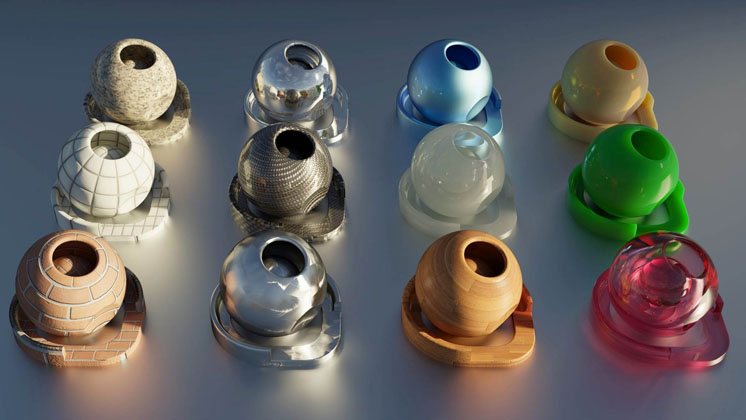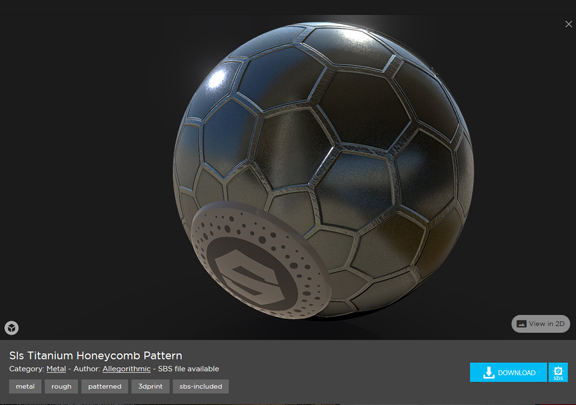Material Matters in Rendering
3D printing applications push rendering developers to match new material properties.

Examples of materials finishes that can be rendered. Image courtesy of NVIDIA.
Engineering Resource Center News
Engineering Resource Center Resources


Latest News
October 12, 2018
Standalone rendering programs like Next Limit’s Maxwell Render and CAD-embedded renderers like SolidWorks Visualize usually come preloaded with a library that includes standard manufacturing materials, such as steel, titanium and plastic. By applying these on your 3D part or assembly model, you can create photorealistic renderings to visualize how your design will look after manufacturing.
But what if you plan to 3D-print your design?
3D printable materials are quite different from classic manufacturing materials in reflectiveness, stiffness, graininess, and other visual properties. Since 3D printing or additive manufacturing (AM) is now used by many not for prototyping but for full-scale production, visualizing 3D-printing projects should also be possible.
To address this void, Allegorithmic released a collection of 3D printing materials, delivered as part of its materials library Substance Source.

Customizable 3D Printing Materials for Rendering
In the announcement, Allegorithmic wrote, “Each material comes with a specific set of parameters that let users vary their visual attributes. Variations are non-destructive, and range from color and roughness to slice shape and regularity. Printer head variations are also included. Designers and 3D artists from all disciplines, including industrial design, architecture, games and VFX, will find much to explore in the 3D Print collection. As 3D printing expands into new industries, each user type will have a photorealistic way to incorporate real world material characteristics and advanced sci-fi patterns into their designs and projects.”
Substance Source materials can be used with high-end renderers or game engines, such as 3ds Max, Maya, Flame Modo, Unity, Unreal, and Cinema 4D. The library as offered part of Substance subscription. It’s integrated into Substance Painter, 3ds Max, Unreal, and Unity.
Connection to CAD
While customizing material properties such as reflectivity, roughness, and texture grains may be second nature to digital artists who work with high-end rendering programs, the process may be a significant learning curve for CAD users. Most CAD users ideally want to render their CAD designs in CAD-integrated renderers or standalone renderers with simple interfaces.
“Substance is integrated within CATIA,” said Nicolas Paulhac, product manager of Substance Source at Allegorithmic. “For other software, you can export the material map and plug it [into the software].”
Now that NVIDIA’s Material Definition Language (MDL) software development kit is offered as open source, the opportunities have expanded. Industrial designers and CAD engineers are likely to see more materials in their favorite rendering application. MDL software—a set of tools that developers can use to integrate the look and feel of real-world materials into rendering applications—gives end users the ability to share physically based materials and lights between supporting applications.
For example, an MDL material created in Allegorithmic Substance Designer can be saved to a library and then used in any other supporting application, like Adobe Dimension CC. Users can build a library of these materials once and be confident they’ll maintain their appearance as they move between applications in a workflow.
The open source NVIDIA MDL SDK gives developers the capability to expand and adapt MDL to specific needs. They can add more functionality, work across more applications, exploit new platforms, port it to iPad or Android, create new backends and more.
With full access to the MDL language, developers can feel at ease building applications around the format as they have unrestricted access to the entire spec.
Developers’ Input
Allegorithmic has already built an entire MDL authoring tool as part of their Substance Designer application. With the MDL source, they have deeper access than ever before.
Adobe has already adopted NVIDIA MDL in Dimension CC for 3D designers.
“At Adobe, we’re very focused on the flow of creative content across the value chain, from initial concept through design all the way to marketing and sales,”said Ross McKegney, director of engineering at Adobe Dimension CC. “We’ve adopted physically based materials based on NVIDIA MDL across all of our next-generation 3D products and services as a robust and elegant way of expressing materials that look the same wherever they are used.”
Open source NVIDIA MDL SDK is available through NVIDIA here.
Subscribe to our FREE magazine, FREE email newsletters or both!
Latest News





